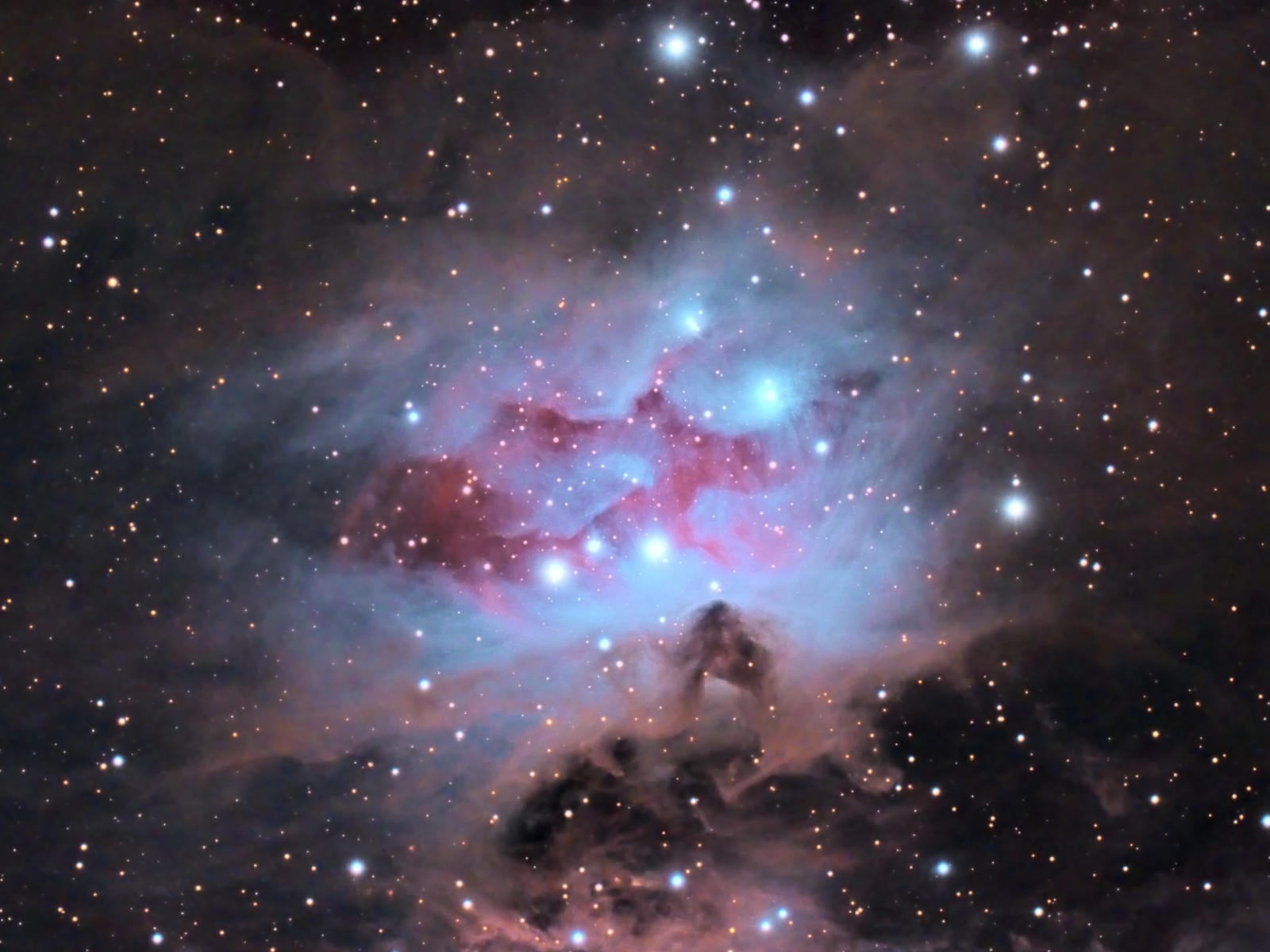NGC 1977, The Running Man Nebula
 Click image for full size version
Click image for full size version
March 31, 2020
The Running Man Nebula, a.k.a. NGC 1977 and Sh2-279, is part of Orion’s Sword, an asterism of star clusters and nebulae below Orion’s Belt. It sits about a little more than the width of the Moon north of the Orion Nebula. The Running Man Nebula includes pink HII emission regions, and blue reflection nebulae. Dark dust throughout gives the area surrounding the bright nebula a smoky texture. This complex lies around 1,500 light years away, and is about 7.5 light years across. I have imaged the whole sword previously, showing the Running Man Nebula in context. My 2010 image of this object is one of my first astrophotos. It’s amazing to me how far I have come in this hobby.
Tekkies:
Acquisition, focusing, guiding and control of Paramount MX mount with TheSkyX. Focus with Optec DirectSync motor and controller. Automation with CCDCommander. Equipment control with PrimaLuce Labs Eagle 3 Pro computer. All pre-processing and processing in PixInsight. Acquired from my SkyShed in Guelph. Minimal moonlight, above average transparency and average or better seeing. Data acquired February 21-March 1, 2020.
Luminance: Sky-Watcher Esprit 150 f/7 refractor and QHY 16200-A camera with Optolong UV/IR filter
Chrominance: Takahashi FSQ-106 ED IV @ f/3.6 and QHY367C one-shot colour camera with Optolong L-Pro filter
Chrominance: 154 x 3m = 462m
Total: 14hr22m
Data Reduction and Processing
Preprocessing: The WeightedBatchPreProcessing script was used to create a Luminance master frame (from the mono camera) and a RGB master frame (from the one-shot colour camera). MUREDenoise was applied to the Luminance master.
Gradient Removal: DBE was applied to L and RGB masters using Subtraction to remove the minimal gradient that remained after integration.
Colour
Channel Registration: To improve channel registration, the colour channels of the RGB master were extracted and aligned with StarAlignment, using Thin Plate Splines with Distortion Correction and the green channel as the reference frame. The registered colour channels were recombined with ChannelCombination.
Colour Balancing: Colour was balanced with PhotometricColorCalibration.
Linear Noise Reduction: MultiscaleLinearTransform was used to reduce noise in the background areas, using an internal mask to protect bright structures. Layer settings for threshold and strength: Layer 1: 5.0 0.85, 2 iterations; Layer 2: 3.5, 0.75, 2 iterations; Layer 3: 3.0, 0.5, 1 iteration; Layer 4: 1.0, 0.25, 1 iteration.
Stretching: HistogramTransformation was applied to make a pleasing, bright image, with background set to an intensity of approximately 0.10.
Lightness
Deconvolution: StarMask was applied with default settings to produce a Local Deringing Support Image. A clone of the image was stretched to use as a deconvolution mask. Deconvolution was applied (100 iterations, regularized Richardson-Lucy, external PSF made using PSFImage script with about 50 stars).
Linear Noise Reduction: MultiscaleLinearTransform was used to reduce noise in the background areas, using an internal mask to protect bright stars. Layer settings for threshold and strength: Layer 1: 3.0 0.85, 1 iterations; Layer 2: 2.0, 0.75, 1 iterations; Layer 3: 1.0, 0.5, 1 iteration.
Stretching: HistogramTransformation was applied to make a pleasing, bright image, with background set to an intensity of approximately 0.10.
Combining Lightness and Colour Images
Registration of L and RGB: DynamicAlignment was used to register the RGB master to the L master.
LRGB Combination: The lightness image was applied to the RGB image using LRGBCombination with default settings.
Additional Processing
Nonlinear Noise Reduction: TGVDenoise was used in L*a*b* mode to reduce noise with a mask used to target the background areas and protect the stars (max. 1000 iterations and convergence selected for both lightness and chrominance).
Contrast Enhancement: LocalHistogramEqualization was applied twice (scale of 50 with strength 1.0; then scale of 150 with strength 0.5) using a mask to protect stars and low-signal regions of the image.
Sharpening: The nebula was sharpened with a pass of MultiscaleLinearTransform (bias +0.15 on 2nd and 3rd layers and dark deranging = 0.05).
Final Steps: Nebula, background and star brightness, contrast, and colour saturation were adjusted in several iterations using CurvesTransformation with masks as required. The DarkStructureEnhance script was applied (strength = 0.20). ICCProfileTransformation (sRGB IEC61966-2.1; Relative Colorimetric with black point compensation) was applied prior to saving as a jpg.






Leave A Comment